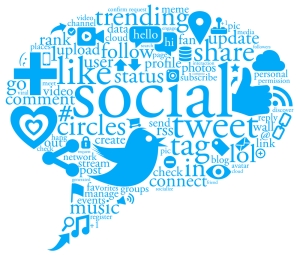
I have always been rather wary of social media. I’ve never really used them all that much. Originally, someone had signed me up for Facebook as a birthday present because she was going off to college and wanted us to stay in touch. Facebook, for me, was always about staying in the know about my friends both near and far. Of course, as soon as I started using it my mother was always hovering over my shoulder asking me who I was talking to, what we were talking about, and reminding me to change my privacy settings and to never agree to meet up with strangers. She acted as if I was seven, and not a senior in high school. I, being a naturally more reserved, have a hard time writing something on Facebook. I don’t feel like anything that I write is worth reading. I found that I used Facebook more like an Instant Messaging platform than anything else. I like Facebook, don’t get me wrong; I just don’t say much.
Twitter was another foreign concept to me. At first I thought it was strange that you don’t have to “confirm” a follower… they just follow. It made it seem much less safe for that reason. Then there was the thought that what I write can be read by almost anyone, not just the people that I pick and choose. So, naturally, I researched it. I looked at online forums and whatnot that talked about Twitter and learned quite a bit. But most of my readings lead me to think that it was more for corporation, organizations, and celebrities. So I stayed away from it. Or at least I did, until my friends Krista, Melissa, and Jamie kept pushing me to try it out. So, I signed up for Twitter one night. I opened it up twice, wrote a couple tweets to my friends and then my account lied dormant for a few months. I wasn’t really into it and I never had anything that seemed important enough to say.
Then, I signed up for this class and I’ve been “forced” to tweet. I’ve found that I actually like using Facebook and Twitter. I still don’t use them as much as my friends or classmates, but I do use them. It’s more fun than I originally thought. I especially like that with Twitter, everything is more fast paced. So if I say something stupid, it’s overshadowed by everyone else’s words before too many people see it. Facebook is more protected, so I can choose who sees what I write and when, so I still don’t write very often. But I’m beginning to open up with Twitter. It may seem less private, but I’ve realized that it doesn’t really matter as long as I don’t do anything too stupid or tell the Twitterverse my home address.
Now blogging was a whole other galaxy of uncomfortable. I’ve written essays in the past. I’ve even written short stories in high school for English. One of them was published in the school literature book my Freshman year. But I have never written anything with the intent of it being completely online and open to whom-so-ever should stumble upon it. The idea was a little bit freaky. My writing skills are not the greatest, and I have a hard time being satisfied with anything that I write up. But, I’ve come to find that blogging is really fun. As soon as I finally get an idea in my head on what to write and how to write it, it’s easy; and, as soon as I realized that the people who are reading it have never met me and, realistically, there aren’t many readers, it became less scary. The words flowed easier and I found myself enjoying writing up blog posts.

The second half of this semester comes with a BIG project. We (the students) have to work with a Non-profit organization. We are to help them with their social media efforts. This is sort of our chance to implement, show off, and improve our social media know how. It will act as a growth and explorations kind of project. So, I’ll detail some of the things that I plan to do.
Facebook, though strange to me, is an important aspect of a Non-profits social media reach. Heather Mansfield, author of “Social Media for Social Good” (SMSG), writes on page 73 that:
“Almost every nonprofit can now argue that it needs to have a presence on Facebook because that’s ‘where our supporters are.’ To take that a step further, increasingly, if your nonprofit does not have a presence on Facebook, then it does not exist to hundreds of millions of people worldwide, and it’s through Facebook pages that nonprofits can best tap into the power of Facebook and make themselves available to the Facebook masses (Mansfield).”
Facebook should be a staple in any nonprofits social media agenda. Twitter has become increasingly popular, but Facebook is still a must. My plan is to utilize Facebook as a starting zone. Everyone needs that first stepping stone to open up the door and Facebook is it. I even go to a Facebook page when feeling out a nonprofit. If they don’t have Facebook, they will when I’m done. If they do, I will work help keep them up to date and give them guidance to continue in that direction. Facebook is kind of an intermediate form; more detailed than Twitter, but less wordy than blogging. You really can’t ask for a better starting place.
Twitter is an amazing tool for quick little updates. If you have just a few words to say or maybe a picture or a link to share, Twitter is the place to post it. On page 92 of SMSG, Mansfield states that: “Communicating messages in short bursts of information, even if they are sometimes grammatically incorrect, is an acquired and valuable skill that is useful in today’s society and economy (Mansfield).” Twitter is one of the best ways to keep followers of what is happening without overloading them with information. Dr. Kristi Jean, NDSCS NanoScience program coordinator, has told me countless times that we live in a world where people don’t read anymore. Not for lack of wanting to, but for lack of time. Twitter is the perfect place to drop off little tidbits of information that followers can read. Facebook supplements it in the fact that it can elaborate on that information more than Twitter. So, what I would do is work with the organization to make a working Twitter presence that works hand in hand with Facebook. The basic idea is that when something is posted on Facebook, it also reaches the Twitterverse to encompass everything. With that, I would also help them with HootSuite. I don’t know how to use it myself, but I think learning with someone else makes it easier.
Blogging of course won’t be left out; I told you I think it’s fun, so why exclude them from that fun? On page 156 of SMSG, Mansfield explains that:
“If a blog is designed and written well, it can transform your nonprofit’s online brand recognition. In fact, for many nonprofits that are struggling to build their e-newsletter lists, online donations, and social networking communities, blogging is often the missing piece in their online communications and development strategies—they just don’t know it (yet) (Mansfield).”
Blogging is important. In the hierarchy of social media, Twitter is the catchphrase; a little piece of information to get you interested. Facebook is what gets you hooked and wanting to read more. Then, blogging is what reels you in. It gives the most information per square meter and really outlines and details what is happening within a nonprofit that day, that week, that month. My goal then would be to help that organization get a blog going on a (semi) regular basis and keep it going. Blogging is interesting. It opens up the door between the reader and the organization and will show people that the nonprofit means business. I would help to show them that and give tips and training on how to write, when to write, and what to write.

Overall big picture, my goal would be to help the organization to implement and understand social media as a whole. I want them to be able to sufficiently use social media to get word out to the world about what their purpose is and what they are in need of at that moment. I will explain to them how to use each of the three forms and keep it all connected and organized so that they don’t miss any readers, friends, or followers.



















